Molded Plastic Aspheric Lenses (AR Coating: 400 - 700 nm)

- Optical-Grade Plastic
- AR Coated for 400 - 700 nm
- Diffraction-Limited Design
CAX183-A
CAW100-A
CAY046-A
CAX100-A
A Laser Diode is Collimated
Using a CAY046 Plastic
Aspheric Lens in an SM1AD8
Adapter Mounted to an LDM21
Laser Diode Mount

Please Wait
Features
- Material: Optical-Grade Plastic
- Outer Diameters of 5.20 mm, 6.28 mm, and 7.40 mm Available
- Effective Focal Lengths from 4.60 mm to 18.15 mm
- AR Coated for 400 - 700 nm
Our Plastic Aspheric Lenses, which are available uncoated or with an antireflection coating for the 400 - 700 nm range deposited on both sides, utilize molding technology to produce all-plastic optics. Designed by Philips for high-volume applications at affordable prices, these optics are ideal for low-power applications requiring lightweight components. The surface of the aspheric lens is designed to reduce spherical aberration, which allows for the spot size and collimation of a monochromatic beam of light to approach the diffraction limit.
In laser diode systems, difficulties with aberration correction are compounded by the beam's high divergence angle. Since individual spherical lenses can refract light at only small angles before spherical aberration is introduced, multiple elements are often required to collimate laser diode light. In contrast, a single aspheric lens collimates without introducing spherical aberration. When used to collimate or focus light, the lens should be oriented so that the side with a larger radius of curvature (i.e., the flatter surface) faces the point source.
Conversely, when coupling light into fiber, it is often necessary to focus the laser light to a near-diffraction-limited spot. With single spherical elements, spherical aberration is the limiting factor to achieving such a small spot size, rather than the diffraction limit. Because these aspheric lenses are corrected to minimize the spherical aberration, the focal spot size can approach the diffraction limit.
All of the plastic aspheric lenses on this page are corrected for the presence of a window, like the window in TO-type laser packages. Please see the Specs tab for details. Additionally, the side of each lens has a flat indent that provides a reference location.
| Item # | CAY046-A | CAW100-A | CAX100-A | CAW110-A | CAX183-A |
|---|---|---|---|---|---|
| Effective Focal Lengtha | 4.60 mm | 9.85 mm | 10.00 mm | 10.92 mm | 18.15 mm |
| Numerical Aperture | 0.40 | 0.195 | 0.20 | 0.19 | 0.12 |
| Clear Aperture | Ø3.7 mm | Ø3.4 mm / Ø3.9 mm (S1 / S2)c |
Ø4.1 mm | Ø4.1 mm | Ø4.3 mm |
| Working Distancea | 3.00 mm | 4.69 mm | 8.48 mm | 9.3 mm | 16.30 mm |
| Outer Diameter | 7.40 mm | 5.20 mm | 6.28 mm | 6.28 mm | 6.28 mm |
| Center Thicknessa | 2.70 mm | 2.52 mm | 1.25 mm | 2.44 mm | 1.09 mm |
| AR Coating Range | 400 - 700 nm | ||||
| Reflectance Over Coating Range (Avg.) | <0.5% @ 0° AOI | ||||
| Wavefront Error, On Axisb (RMS) | 0.040λ | 0.040λ | 0.080λ | 0.040λ | 0.030λ |
| Wavefront Error, Totalb (RMS) | 0.070λ | 0.050λ | 0.090λ | 0.055λ | 0.035λ |
| Surface Quality | 80-50 Scratch-Dig | ||||
| Material | Acrylic | Cyclic Olefin Copolymer | Polycarbonate | Cyclic Olefin Copolymer | Polycarbonate |
| Design Wavelength | 670 nm | 785 nm | 670 nm | 670 nm | 785 nm |
| Laser Window Correction | 0.25 mm (N-BK7) | 5 mm (SF11) | 0.25 mm (N-BK7) | 0.25 mm (N-BK7) | 0.25 mm (N-BK7) |
| Operating Temperature | 5 to 65 °C | 0 to 65 °C | 0 to 65 °C | -10 to 75 °C | -10 to 75 °C |
| Storage Temperature | -10 to 70 °C | 0 to 65 °C | 0 to 65 °C | -25 to 100 °C | -25 to 100 °C |
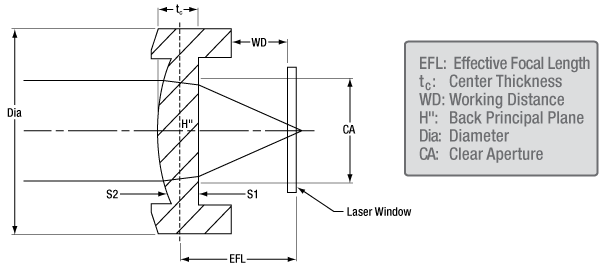
Figure 2.1 Please note the effective focal length is determined from the back principal plane, which does not coincide with the flat surface of the lens.
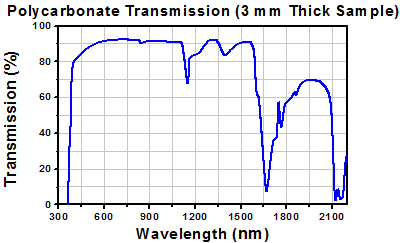
Click to Enlarge
This transmission curve shows total transmission through uncoated polycarbonate, including surface reflections. Our CAX100-A and CAX183-A plastic aspheric lenses are fabricated from this material and then an antireflection coating for 400 to 700 nm is deposited on the surface.
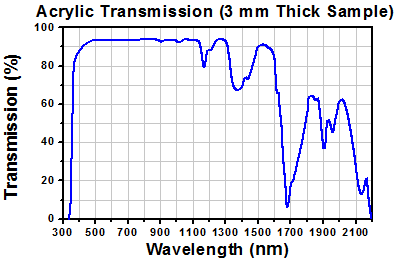
Click to Enlarge
This transmission curve shows total transmission through uncoated acrylic, including surface reflections. Our CAY046-A plastic aspheric lens is fabricated from this material and then an antireflection coating for 400 to 700 nm is deposited on the surface.
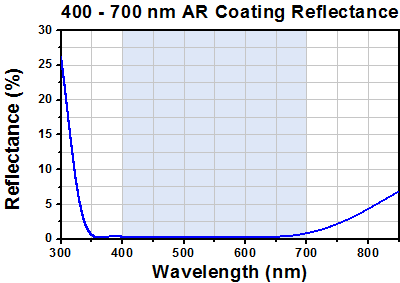
Click to Enlarge
The shaded region denotes the wavelength range for which these are specified.
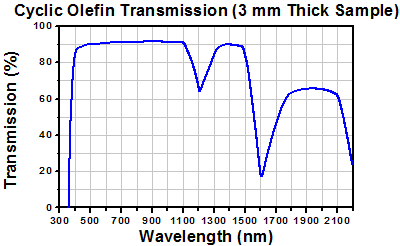
Click to Enlarge
This transmission curve shows total transmission through uncoated cyclic olefin copolymer, including surface reflections. Our CAW110-A and CAW100-A plastic aspheric lenses are fabricated from this material and then an antireflection coating for 400 to 700 nm is deposited on the surface.
| Posted Comments: | |
colin marcus
(posted 2024-11-14 17:05:06.367) Can polycarbonate lenses really be used at 405nm? I ask because the transmittance spectrum graph shows the cutoff right at 395 or 400nm. Also, will the polycarbonate degrade when exposed to 405 nm laser light? cdolbashian
(posted 2024-11-26 04:43:26.0) Thank you for reaching out to us with this inquiry. We have contacted you directly to discuss your application. dwightsehler
(posted 2013-10-23 21:07:29.853) Good day,
Can I get the Zemax prescription for lens CAW110-A from you? My copy of Zemax doesn't have this lens.
Thank you,
Dwight Sehler
dwightsehler@aol.com
720-335-2756 tcohen
(posted 2013-10-29 13:10:00.0) Response from Tim at Thorlabs: Thanks for contacting us. I’ve sent the Zemax file to your email. |
 Products Home
Products Home







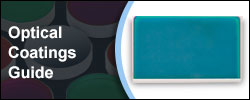

 Plastic Aspheres: AR Coated 80-50 Scratch-Dig
Plastic Aspheres: AR Coated 80-50 Scratch-Dig